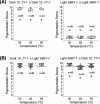This is a preprint.
Evolution of dominance in a Mendelian trait is linked to the evolution of environmental plasticity
- PMID: 40661345
- PMCID: PMC12258707
- DOI: 10.1101/2025.05.30.657093
Evolution of dominance in a Mendelian trait is linked to the evolution of environmental plasticity
Abstract
Allelic dominance and phenotypic plasticity both influence how genetic variation is expressed in phenotypes, shaping evolutionary responses to selection. In both cases, changes in genotype or environment can cause sharp, nonlinear phenotypic shifts, hinting at shared underlying features of development that may link dominance and plasticity. Here, we investigate these links using a Mendelian, female-limited color dimorphism found in many species of the Drosophila montium lineage. In most species, the Dark allele is dominant, but two species-D. jambulina and D. cf. bocqueti-have been reported to have dominant Light alleles. We show that in both Dark-dominant and Light-dominant species, the color dimorphism is linked to the same locus: the POU domain motif 3 (pdm3) transcription factor. We then demonstrate that the interspecific differences in dominance relationships between pdm3 alleles are due to changes in phenotypic plasticity. In the Dark-dominant species D. rufa and D. burlai, the Dark allele is dominant across all developmental temperatures. In contrast, in both Light-dominant species, dominance is temperature-dependent, with the Light allele becoming increasingly dominant at higher temperatures. These results suggest a mechanistic connection between the evolution of dominance and phenotypic plasticity. We propose this connection may emerge from threshold-like properties of developmental systems.
Keywords: Drosophila pigmentation; Evolution of dominance; developmental thresholds; evolution of phenotypic plasticity; genotype-phenotype mapping; sex-limited polymorphism.
Conflict of interest statement
Conflict of interest: The authors declare no conflict of interest.
Figures








References
-
- Barson NJ, Aykanat T, Hindar K, Baranski M, Bolstad GH, Fiske P, Jacq C, Jensen AJ, Johnston SE, Karlsson S. (2015). Sex-dependent dominance at a single locus maintains variation in age at maturity in salmon. Nature. 528, 405–408. - PubMed
Publication types
Associated data
Grants and funding
LinkOut - more resources
Full Text Sources
